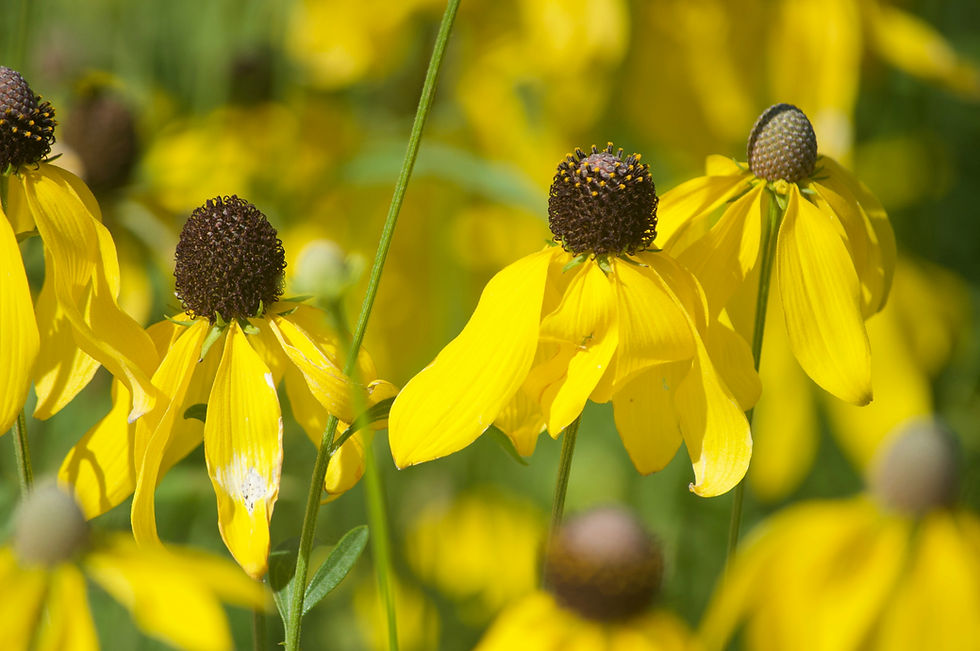Native vs. Adapted Plants: Why the Difference Matters for Houston Landscapes
- urbanecoland
- Aug 8
- 4 min read
If you’ve spent time browsing a nursery in the Greater Houston area, you’ve probably heard two common terms: native plants and adapted plants. At first glance, they might seem interchangeable—both can grow here without constant babying—but there’s an important difference that affects everything from your water bill to the number of butterflies in your backyard.

As Douglas W. Tallamy explains in Bringing Nature Home, our landscaping choices aren’t just aesthetic—they’re ecological decisions. Every plant we put in the ground either supports or disrupts the delicate food web that keeps our ecosystems alive.
What is a Native Plant?
A native plant is one that has evolved over thousands of years alongside the wildlife in a particular region. These plants are perfectly adapted to local soils, rainfall patterns, and temperature swings. More importantly, they have deep relationships with local insects, birds, and other wildlife—relationships that non-native species simply can’t replicate.
Houston native plant examples:
Gulf Coast Penstemon (Penstemon tenuis) – Thrives in our humid climate and supports native bee species.
Lindheimer’s Muhly (Muhlenbergia lindheimeri) – A graceful native grass that provides cover for ground-nesting birds and seeds for small mammals.
Yaupon Holly (Ilex vomitoria) – Evergreen shrub or small tree with red berries that feed birds in winter and provide shelter year-round.
When you plant natives, you’re putting back a piece of the original ecological puzzle—one that local wildlife immediately recognizes as “home.”
Texas Native vs. Native to the Gulf Coast
Not all “Texas natives” are created equal—at least when it comes to thriving in Houston’s climate. Texas is huge, spanning multiple ecosystems from piney woods to desert. A plant that’s native to West Texas or the Hill Country might still be called “native” in a Houston nursery, but it evolved in a very different climate.
Example:
Texas Sage (Leucophyllum frutescens) – Native to arid West Texas. In Houston’s humidity and heavy clay soils, it often struggles without perfect drainage.
Gulf Coast Penstemon (Penstemon tenuis) – Native specifically to the Gulf Coast prairie and woodlands, making it naturally suited to Houston’s humidity, rainfall, and soil.
When possible, choose plants that are native to our region—the Gulf Coast Prairie, Piney Woods, and nearby coastal ecosystems. These plants are most likely to thrive with minimal input and provide the exact resources local wildlife needs.
What is an Adapted Plant?
Adapted plants are non-native species that happen to grow well in Houston’s conditions without becoming invasive. They may come from similar climates—such as parts of Mexico, the Mediterranean, or Australia—and once established, they can thrive with minimal irrigation or pest control.
Examples of adapted plants for Houston:
Mexican Feather Grass (Nassella tenuissima) – Beautiful movement in the landscape, drought-tolerant, and easy to grow here.
Vitex (Vitex agnus-castus) – Long bloom season, attracts pollinators, but offers less ecological value to native insects than true Gulf Coast species.
Adapted plants are often used for their looks and resilience, but they don’t always fill the same ecological role as natives. A butterfly may sip nectar from a Vitex, but its caterpillars may not be able to use the leaves as food—meaning the life cycle can’t continue.
Tallamy’s Philosophy: More Than Just Pretty Plants
Douglas W. Tallamy’s core message in Bringing Nature Home is simple:
If you want to sustain wildlife, you have to feed the insects.
Insects are the foundation of the food chain, and most are specialists—they can only eat the plants they’ve evolved with. Without the right host plants, insect populations crash, which in turn affects birds, reptiles, and even mammals.
For example:
A yard full of adapted plants like Mexican Feather Grass might look great and need little water, but it won’t support as many species of caterpillars or native bees.
A yard that includes Purple Coneflower (Echinacea purpurea) or Black-eyed Susan (Rudbeckia hirta) will feed dozens of native pollinator species—helping not just your garden but the larger ecosystem.
How to Balance Native and Adapted Plants in Houston Landscapes
While the ideal would be 100% natives (preferably native to the Gulf Coast region), many Houston gardeners find a blend works best. Adapted plants can fill aesthetic gaps, extend bloom seasons, or provide special design features. But for every adapted plant you choose, make sure there are multiple true region-specific natives nearby to keep the ecosystem intact.
Practical tips:
Start with structure: Use native shrubs like Yaupon Holly for evergreen form and winter food for birds.
Layer with native perennials: Gulf Coast Penstemon, Black-eyed Susan, and Purple Coneflower are great mid-layer choices.
Accent with adapted plants: Use adapted species for color contrast or unique forms, but keep them in the minority.
The Takeaway
In Houston, you have countless options for plants that will grow beautifully. But only plants native to our region will reconnect your yard to the local ecosystem. Texas natives from other regions may grow here, but they don’t always provide the same benefits—or thrive as effortlessly. Adapted plants can play a role, but if you want to be part of the solution to declining insect and bird populations, prioritize region-specific natives whenever possible.
As Tallamy reminds us: every yard, every balcony, every planting bed is a piece of the larger puzzle. The more native pieces we put back, the more complete—and resilient—our local environment becomes.




Comments